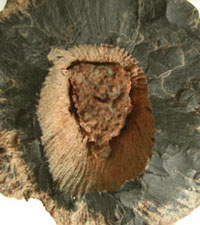Illusion by illumination

The image seen here on the right may remind the observer to
look at
things from more
than one side. It seems to be a bird's view of a hill lit by the low
sun while the surrounding plain is in the shade, with erosion
furrows running down the steep slopes, and with the remains of an
ancient hill fort on the plateau on top, enclosed by decaying walls.
 By turning the picture, something quite
different suddenly
appears, which seems to be a weathered statuette of a saint in a vault
adorned with ray-like grooves.
By turning the picture, something quite
different suddenly
appears, which seems to be a weathered statuette of a saint in a vault
adorned with ray-like grooves.
Really it is neither. It
is a Lower Permian calamite fragment suitable for small talk about
illusion and reality in a confusing world
where hills may be not real but apparitions can be touched.
To
be serious, the present illusion is only another manifestation of the
well-known fact that photographs of less-common objects should be taken
with light coming from above left in order that the shadows produce the
proper 3D-effect. With the picture turned upside
down, as shown above, the light comes from below right,
which makes all the difference between the visual impressions.
The brain is not accustomed to pictures taken with light from below
right
and therefore processes them, in the absence of other clues, as if the
light had come from above left, thereby creating,
in the present case, the image of a hill
instead of a depression. The phenomenon is
particularly striking when a print of the picture is turned slowly
until the brain suddenly switches to the alternative image.
More often than not, photographs
in publications are presented with such orientation that they are misleading.
For the palaeobotanical aspect of
this fossil see Fossil
Wood News 13.
Sample: found
during the IOPC VIII conference (2008) on a field trip to
Schallodenbach, Saar-Nahe Basin, Germany.
H.-J. Weiss 2012

 By turning the picture, something quite
different suddenly
appears, which seems to be a weathered statuette of a saint in a vault
adorned with ray-like grooves.
By turning the picture, something quite
different suddenly
appears, which seems to be a weathered statuette of a saint in a vault
adorned with ray-like grooves.